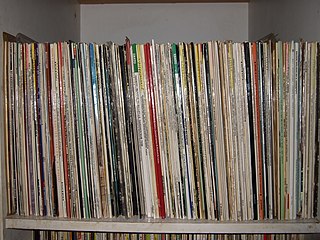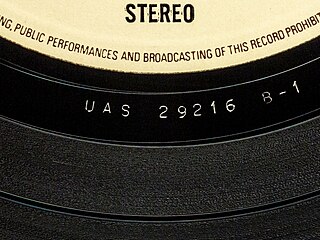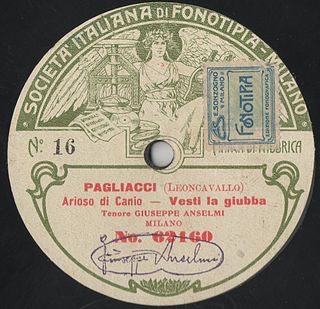
Decca Records is a British record label established in 1929 by Edward Lewis. Its U.S. label was established in late 1934 by Lewis; Jack Kapp, American Decca's first president; and Milton Rackmil, who later became American Decca's president. In 1937, anticipating Nazi aggression leading to World War II, Lewis sold American Decca and the link between the U.K. and U.S. Decca labels was broken for several decades. The British label was renowned for its development of recording methods, while the American company developed the concept of cast albums in the musical genre.

A phonograph record, a vinyl record, or simply a record or vinyl is an analog sound storage medium in the form of a flat disc with an inscribed, modulated spiral groove. The groove usually starts near the periphery and ends near the center of the disc. For about half a century, the discs were commonly made from shellac, with earlier records having a fine abrasive filler mixed in. Starting in the 1940s, polyvinyl chloride became common, the "vinyl records" of the late 20th century.

The Victor Talking Machine Company was an American recording company and phonograph manufacturer that operated independently from 1901 until 1929 when the company was purchased by the Radio Corporation of America and subsequently operated as the RCA Victor Division of the Radio Corporation of America.

Berliner Gramophone – its discs identified with an etched-in "E. Berliner's Gramophone" as the logo – was the first disc record label in the world. Its records were played on Emile Berliner's invention, the Gramophone, which competed with the wax cylinder–playing phonographs that were more common in the 1890s and could record.
This is the discography of Apple Records, a record label formed by the Beatles in 1968. During its early years, the label enjoyed a fair degree of commercial success, most notably with Mary Hopkin and Badfinger, as well as discovering acts such as James Taylor and Billy Preston who would go on to greater success with other labels. However, by the mid-1970s, Apple had become little more than an outlet for the Beatles' solo recordings. After EMI's contract with the Beatles ended in 1976, the Apple label was finally wound up. The label was reactivated in the 1990s with many of the original Apple albums being reissued on compact disc, and the company now oversees new Beatles releases such as the Anthology and 1 albums as well as the 2009 Beatles remastering programme. In 2010, Apple set about remastering and reissuing its back catalogue for a second time.

The twelve-inch single is a type of vinyl gramophone record that has wider groove spacing and shorter playing time with a "single" or a few related sound tracks on each surface, compared to LPs which have several songs on each side. It is named for its 12-inch (300 mm) diameter. This allows for louder levels to be cut on the disc by the mastering engineer, which in turn gives a wider dynamic range, and thus better sound quality. This record type is commonly used in disco and dance music genres, where DJs use them to play in clubs. They are played at either 33+1⁄3 or 45 rpm. The conventional 7-inch single usually holds three or four minutes of music at full volume. The 12-inch LP sacrifices volume for extended playing time.

An album is a collection of audio recordings issued on compact disc (CD), vinyl, audio tape, or another medium such as digital distribution. Albums of recorded sound were developed in the early 20th century as individual 78 rpm records collected in a bound book resembling a photo album; this format evolved after 1948 into single vinyl long-playing (LP) records played at 33+1⁄3 rpm.

The overwhelming majority of records manufactured have been of certain sizes, playback speeds, and appearance. However, since the commercial adoption of the gramophone record, a wide variety of records have also been produced that do not fall into these categories, and they have served a variety of purposes.

Picture discs are gramophone (phonograph) records that show images on their playing surface, rather than being of plain black or colored vinyl. Collectors traditionally reserve the term picture disc for records with graphics that extend at least partly into the actual playable grooved area, distinguishing them from picture label discs, which have a specially illustrated and sometimes very large label, and picture back discs, which are illustrated on one unplayable side only.
Angel Records was a record label founded by EMI in 1953. It specialised in classical music, but included an occasional operetta or Broadway score. and one Peter Sellers comedy disc. The famous Recording Angel trademark was used by the Gramophone Company, EMI and its affiliated companies from 1898. The label has been inactive since 2006, when it dissolved and reassigned its classical artists and catalogues to its parent label EMI Classics and merged its musical theatre artists and catalogues into Capitol Records.

Odeon Records is a record label founded in 1903 by Max Straus and Heinrich Zuntz of the International Talking Machine Company in Berlin, Germany. The label's name and logo come from the Odéon-Théâtre de l'Europe in Paris.

Record collecting is the hobby of collecting sound recordings, usually of music, but sometimes poetry, reading, historical speeches, and ambient noises. Although the typical focus is on vinyl records, all formats of recorded music can be collected.

An album cover is the front packaging art of a commercially released studio album or other audio recordings. The term can refer to either the printed paperboard covers typically used to package sets of 10 in (25 cm) and 12 in (30 cm) 78-rpm records, single and sets of 12 in (30 cm) LPs, sets of 45 rpm records, or the front-facing panel of a cassette J-card or CD package, and, increasingly, the primary image accompanying a digital download of the album, or of its individual tracks.
Varèse Sarabande is an American record label, owned by Concord Music Group and distributed by Universal Music Group, which specializes in film scores and original cast recordings. It aims to reissue rare or unavailable albums, as well as newer releases by artists no longer under a contract. The label's name was derived from combining French-born composer Edgard Varèse's last name with the musical term sarabande, a slow Spanish dance.

Record Collector is a British monthly music magazine. It was founded in 1980 and distributes worldwide.

A matrix number is an alphanumeric code stamped or handwritten into the run-out groove area of a phonograph record. This is the non-grooved area between the end of the final band on a record's side and the label, also known as the run-off groove area, end-groove area, matrix area, or "dead wax".
David Leonard Miller was an American record producer and the founder of many budget album record companies. Miller is more familiar to some record buyers and collectors as the notorious Leo Muller who produced many Exploito type records.

Fonotipia Records, or Dischi Fonotipia, was an Italian gramophone record label established in 1904 with a charter to record the art of leading opera singers and some other celebrity musicians, chiefly violinists. Fonotipia continued to operate into the electrical recording era, which commenced in 1925–26, by which time the company had been absorbed into Odeon records. The records made by Fonotipia are prized by collectors and musicologists for their high technical quality, and for the high artistic merit and interest of much of what was captured for posterity.
In the production of phonograph records – discs that were commonly made of shellac, and later, vinyl – sound was recorded directly onto a master disc at the recording studio. From about 1950 on it became usual to have the performance first recorded on audio tape, which could then be processed and/or edited, and then dubbed on to the master disc.
Bill Haley & His Comets recorded many singles and albums. The following list references only their original release and generally does not include compilation albums or single reissues. This list does not include releases on which the Comets worked as session musicians, and primarily focuses on releases during Haley's lifetime.














